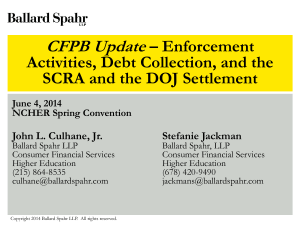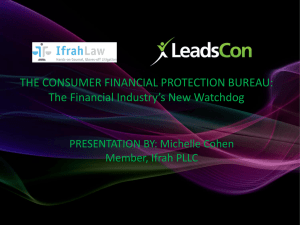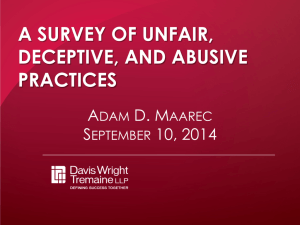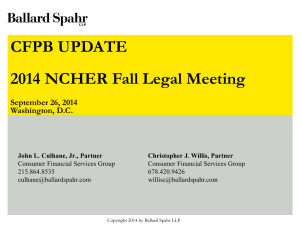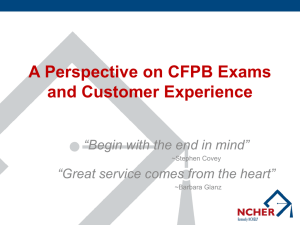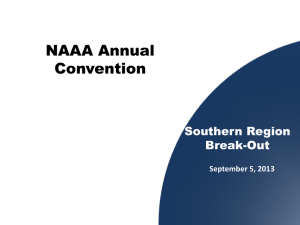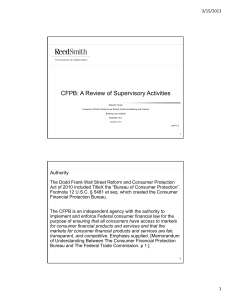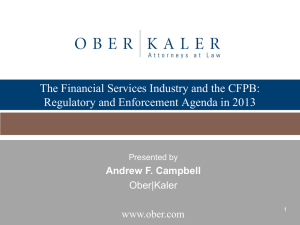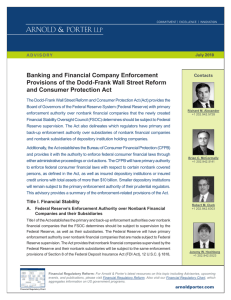A Look at CFPB Enforcement Actions
advertisement
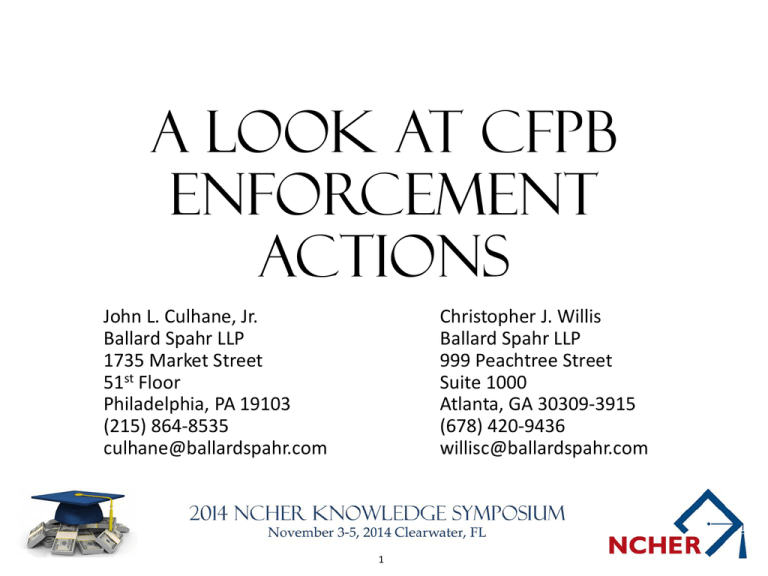
A Look At cfpb enforcement actions John L. Culhane, Jr. Ballard Spahr LLP 1735 Market Street 51st Floor Philadelphia, PA 19103 (215) 864-8535 culhane@ballardspahr.com Christopher J. Willis Ballard Spahr LLP 999 Peachtree Street Suite 1000 Atlanta, GA 30309-3915 (678) 420-9436 willisc@ballardspahr.com 1 CFPB Enforcement Activity to Date • Extremely active in enforcing consumer protection laws • As of July 21st, $4.6B in relief for approximately 15M consumers allegedly harmed by unlawful practices • Another $150M in civil penalties as a result of CFPB enforcement actions • Actions touch every corner of the consumer financial services industry • The number of problems resolved through the confidential supervisory examination process pales in comparison • As of July 21st, supervisory actions and self-reported violations have result in $75M in remediation to to approximately 775,000 consumers 2 Overview of Outcomes • Investigations rarely closed without an enforcement action • Most investigations result in Consent Orders, not litigation • Restitution and injunctive remedies are touted as holding “bad actors accountable and help[ing] consumers harmed by illegal practices” • The outcomes almost invariably include a civil penalty • Generally about 15% to 25% of the restitution amount • Often include a requirement to report on increased monitoring and training efforts; may include review of the associated compliance program and enhancement of procedures to prevent future violations 3 Enforcement Themes • Notwithstanding any shorter SOL, investigations generally go back three to five years • “Hurry up and wait” approach • Sometimes technical compliance is a focal point but more often the focus is on the UDAAP proscriptions, particularly the proscription against deceptive acts or practices, and the risk that the practice poses to consumers • The outcome often includes “new” or “aspirational” standards that are not required by law or likely not obtainable in contested litigation • The “Regulation by Consent Decree” phenomenon 4 Enforcement Themes (cont.) • An enforcement action may be accompanied by associated “guidance” designed to underscore the industry or crossindustry nature of the issue; or “guidance” may be the precursor to an enforcement action • E.g., CFPB Bulletin 2012-06 (Marketing of Credit Card Add-On Products), issued simultaneously with Capital One Consent Order • E.g., CFPB Bulletin 2013-02 (Indirect Auto Lending and Compliance with the Equal Credit Opportunity Act), touted as giving “fair notice on fair lending” • The use of Consent Orders to establish “new” or “aspirational” industry standards is reminiscent of approach historically taken by state attorneys general 5 Responsible Conduct • CFPB Bulletin 2013-06: Credit for Responsible Conduct • Reality: Hard to discern readily apparent, positive impact • No objective proof of credit for responsible conduct • CFPB claims responsible conduct influences decision, but no way to test • Remediation seems to be a strict liability standard • But may still be the best course of action • Lessen the desire to “punish” (i.e., impose civil penalties) or the extent of the civil penalties • Impact on the relationship going forward 6 FTC DEBT COLLECTION ENFORCEMENT ACTIVITY • Growing emphasis on litigation and stronger remedies • In 2013, FTC brought or resolved nine debt collection cases and, in one, assessed largest civil penalty to date, $3.2M • Focus on “new and troubling issues” in debt collection, including text message-based collections and “phantom debt” collections • Same pattern continuing throughout 2014 • FTC has brought or resolved at least 15 cases so far, assessing a $1.5M penalty in one and a $2.0M penalty in another • Continued focus on “phantom debt” collections but also on use of deception to assess convenience fees and to gain access to bank accounts for payments 7 Debt Collection Enforcement (cont.) • Recurring issues • • • • • • • • Failure to self-identify as debt collector Failing to provide information in writing about the debt Failure to follow FTC protocol for voicemail messages Improper disclosure of debt to third parties (typically family members, employers, and co-workers) Harassing calls and repeated inconvenient or prohibited calls Ignoring “do not call” and “do not contact” directives Assessment of unauthorized convenience fees Unauthorized withdrawals from bank accounts 8 DOJ SCRA ENFORCEMENT ACTIVITY– SCRA Complaint • Alleged “pattern or practice” of violations of Section 521 by: • Obtaining 5 default judgments over five years without filing affidavits and showing necessary facts to support same • Alleged “pattern or practice” of violations of Section 527 by: • Failing to lower rates after receiving written notice and qualifying active duty orders • Failing to make acceptable efforts to obtain qualifying active military duty documents from servicemembers who requested benefits but did not provide orders • Failing to notify servicemembers that they might be eligible for rate reductions when they provided their military documents for other purposes 9 The New SCRA Default Judgment Rules • Initial review within 2 business days before collection referral • Search of DMDC data base and review of all information in company’s possession, including customer notes • For borrower in military service, no referral or referral only with special warning • Subsequent review after defendant’s failure to file timely answer and within 2 business days before seeking default • Search of DMDC data base and review of all information in company’s possession, including customer notes • For borrower in military service, file affidavit so stating, attach DMDC certificate with date stamp no more than 2 business days before affidavit execution, and file copy of orders if available 10 The New SCRA Rate Reduction Rules • Accept as written notice (request): • Military orders • Request for military deferment or forbearance • Submission through new online process • Accept as military orders: • Letter from commanding officer with specified information • Results of search of DMDC database (required if notice and no orders; for positive result – send notice of right to dispute eligibility dates; for negative result – send notice requesting copy of documents establishing service) • Likely exception – federal student loans (DCL ID: GEN-14-16) 11 Hot Regulatory and Litigation Issues • “Structurally unfair” allegations by CFPB and other regulators (ITT, Corinthian cases) • Underwriting: making loans (or certain loss mitigation options) too easy vs. too difficult to obtain (UDAAP) • Underwriting – cohort default rate and other schoolspecific variables (ECOA) • Payment processing and payment application (minimum payment, late fees, posting, failed debits, allocation, multiple loans, etc.) (UDAAP) • Application of prepayments and partial payments – “pay ahead” or other; crediting or suspense (UDAAP) 12 Hot Issues (cont.) • ACH-related disclosures, especially when payments change (EFTA) • Treatment of military borrowers (SCRA, UDAAP) • Letters/scripts and other collection issues, including statements about bankruptcy (FDCPA and UDAAP) • Loss mitigation options – imposing federal-like requirements on private loans (deferment, forbearance, rehabilitation, income-based repayment) (UDAAP) • Refinancing – disclosure of loss of benefits (UDAAP) • Servicing transfers – notice of same and impact of transfer on borrower benefits (UDAAP) 13 Comments or questions Thank you for having us speak today. If you have any comments or questions, please contact us: John L. Culhane, Jr. Ballard Spahr LLP 1735 Market Street 51st Floor Philadelphia, PA 19103 (215) 864-8535 culhane@ballardspahr.com Christopher J. Willis Ballard Spahr LLP 999 Peachtree Street Suite 1000 Atlanta, GA 30309-3915 (678) 420-9436 willisc@ballardspahr.com 14
